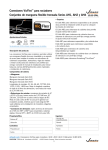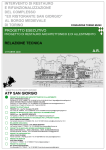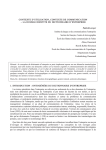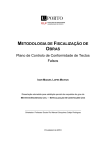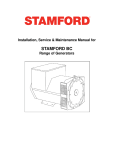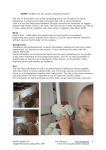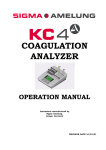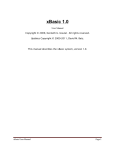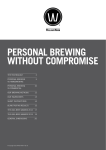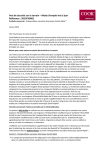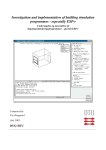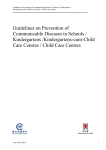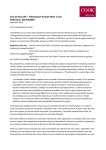Download indoor climate in kindergartens, air -uality
Transcript
Indoor climate in kindergartens, air quality David Hafsteinsson CAHS73 7th semester dissertation Indoor climate in kindergartens “Air quality” By: David Hafsteinsson Bachelor of architectural technology and construction management Consultant: Jens Peder Pedersen Hand in: May 2011 VIA UNIVERSITY COLLEGE, Horsens Campus, Denmark 1 Indoor climate in kindergartens, air quality David Hafsteinsson CAHS73 TITLE PAGE Dissertation title: Indoor climate in kindergartens Consultant: Jens Peder Pedersen Author: David Hafsteinsson Date/signature: _______________________________ Student identity number: 125391 Number of copy’s: 3 Number of pages: 39 All rights reserved – no part of this publication may be reproduced without the prior permission of the author. NOTE: This dissertation was completed as part of a Bachelor of Architectural Technology and Construction Management degree course – no responsibility is taken for any advice, instruction or conclusion given within! 2 Indoor climate in kindergartens, air quality David Hafsteinsson CAHS73 Acknowledgements I what to thank a few institutes and a few people that helped me along the way to get the result of this report, it wouldn’t have been possible without their help: Vuggestuen miniflint Flintebakken børnehave Stensballe børnehave Rytterkilden børnehave Børnehaven Gasvej And the 100 Facebook friend that have helped me out in my survey. Thank you good people so much for helping me out. 3 Indoor climate in kindergartens, air quality David Hafsteinsson CAHS73 Abstract In this report I will go in depth of the indoor climate in kindergartens air quality. What tools can we use to get good results for indoor climate, what are the regulations and standards. How planning a project that has to be designed with good indoor climate in mind. I will go into the quality assurance of materials and air quality. I will research health issues that are caused of bad ventilation, moist in the construction and bad materials. What kind of ventilation is used when designing a kindergarten? Is it important to clean and maintain kindergartens? I made two surveys that show what people think of the kindergartens that their children are in and also the people that work in the kindergartens. Last but not least I talk about the cost of kindergartens with high standard indoor climate. All of these topics and more, have I taken in consideration and tried to look at from all angles to try to understand and get to know how to get the best indoor climate possible. All of my researches have been made on the internet, looking through regulations, talking to people and going to different types of kindergartens to investigate the air quality in them. 4 Indoor climate in kindergartens, air quality David Hafsteinsson CAHS73 TableofContents Problem statement ........................................................................... 7 Introduction ..................................................................................... 8 Indoor climate ............................................................................... 8 Why? ........................................................................................... 9 Regulations and demands ................................................................ 10 General ...................................................................................... 10 Ventilation .................................................................................. 10 Materials .................................................................................... 12 Lighting ...................................................................................... 13 Daylight ................................................................................... 13 Acoustic lighting ....................................................................... 14 Indoor climate in kindergartens ........................................................ 15 Planning ..................................................................................... 15 General ................................................................................... 15 Decision making: ...................................................................... 16 Suggestion ............................................................................... 17 Designing and solving ................................................................ 17 Materials .................................................................................... 20 Quality assurance ..................................................................... 20 International ............................................................................ 21 Getting the “logo” ..................................................................... 21 Træ ......................................................................................... 23 Good materials ......................................................................... 23 CO2 (Carbon dioxide)................................................................. 24 Heating.................................................................................... 26 Air quality ................................................................................... 28 Ventilation ............................................................................... 28 Areas with bad indoor climate!.................................................... 30 Temperature ............................................................................ 31 Cleaning .................................................................................. 31 Equipment’s to measure air quality ............................................. 32 5 Indoor climate in kindergartens, air quality David Hafsteinsson CAHS73 My researches ............................................................................. 32 Is the indoor climate good? ........................................................ 34 Costs of good air quality ............................................................... 35 Conclusion .................................................................................. 37 List of references ............................................................................ 38 Webpages: ............................................................................... 38 Regulations: ............................................................................. 38 Table of figures .............................................................................. 39 6 Indoor climate in kindergartens, air quality David Hafsteinsson CAHS73 Problem statement I have chosen to write this report to investigate if the indoor climate is good enough in kindergartens. And if it´s not, how can we fix it to make it better for our children. The subject came up because I have a little 3 year old daughter and I have been to a few kindergartens and the indoor climate is so different in every one of them. My research questions: What are the regulations that you have to follow in order to get a good indoor climate? Ventilation systems, what´s the best solution? What are the best building materials for building our kindergartens Heating systems, what is the best solution? Is it expensive to have a good indoor climate? Where are the biggest climate problem areas in kindergartens? The goal is to get a good and useful solution from this report. I´m going to try to go to some kindergartens here in Horsens and talk to people that work in the kindergartens and base my recherché on that. Quote specialist in the subject of good indoor climate. David Hafsteinsson 7 Indoor climate in kindergartens, air quality David Hafsteinsson CAHS73 Introduction Indoor climate Man started very soon to take notice of the indoor climate in his buildings. There are documented evidence that the Greek and Roman “architects” (460-377 BC) were very aware of that polluted air inside their buildings was not good for peoples health, but on the other hand there are no documents saying that they did something about it other than opening a window or something in that direction. Indoor climate started to be a big issue for designers and developers, around 1960´s when the energy crises hit Europe, designers started to think seriously about the indoor climates in buildings. At the time it started to become important to get a good indoor climate for health reasons because people were becoming sick for “no reason”. But investigation led to the conclusion that the reason for it was bad indoor climate in our buildings. In the developed world indoor air quality is a main cause of allergies, hypersensitivity reactions, airway infections and also small things like; irritation to the eyes, nausea, dizziness, headaches, tiredness and emotional unstableness. Every country has their own regulations for indoor climate in buildings. In Denmark there are few regulations, these regulations am I using as guidelines for this report. The regulations are; BR10 (Building Regulation 2010), SBI 196 (Statens Byggeforskningsinstitut 2000, indeklimahåndbogen) and DS 474 (Dansk Standard 474, Norm for specification af termisk indeklima). There are three classes of indoor climate; A, B and C, where A is the highest and the C is the lowest. Of course should every building have an indoor climate class A, but to make your building a class A building has its 8 Indoor climate in kindergartens, air quality David Hafsteinsson CAHS73 price and the better the indoor climate is the higher the price is and that is not always possible or in the picture. Why? Why is indoor climate so important for us? Because recent studies have shown that we the western nations spend almost 90% of our time inside a house/building, either at home or at work. That is why it is easy to understand that the most important environment in relation to our health is the indoor environment. During the breakthrough of modern hygiene, from mid-19th century, indoor environmental issues received a lot of attention. Attention that is understandable and an attention that should have come much earlier. It is very important that we try to make the climate inside our kindergartens as good as possible for the sake of our children, because they are the future. 9 Indoor climate in kindergartens, air quality David Hafsteinsson CAHS73 Regulations and demands General In the regulations there is talked about, that a building should be designed for its usage and were people are working or staying for a “X” amount of time, there should be designed a good and healthy indoor climate so the people living and working in the building will be happy and satisfied. Of course there is no smoking in kindergartens that would be a disaster for the indoor climate. There are 3 main things that the regulations says you have to have in mind, in order to get a good and healthy indoor climate in your kindergarten; ventilation, materials and lighting, these thing are crucial if an good indoor climate should be reached. Ventilation Buildings should be ventilated to get the best indoor climate they possibly can. The ventilation systems should be calculated, mounted and kept maintained by professionals for the best resolution for the indoor climate. All ventilation calculations should be calculated in order to the DS 447 witch is the Danish Standard for ventilation. The air changes are very important for a good indoor climate and all the regulations have very strict demands about that for kindergartens. When designer/engineers starts on a new project they have to calculate the air flow in and out of a building and treat every building case differently, they also have to consult with the producers/manufactures of the ventilation aggregates. 10 Indoor climate in kindergartens, air quality David Hafsteinsson CAHS73 The air changes in kitchens, toilets, WCs, compartments and other rooms like that shall detract and extract a certain amount of air; in kitchens there should be detracted 20 l/s, from toilets and WCs there should be detracted 15 l/s and in compartments and other rooms there should be detracted 10 l/s. In other rooms and areas the dimensioning and approval of the ventilation should have the approval of the local authorities. Kindergartens shall be ventilated with ventilation aggregate for example heat recovery, that lets the fresh air in and take the old damp air out. That gives the best indoor climate for our children. If you use the heat recovery aggregate in kindergartens the air that is blown in and the air that is sucked out should be at least 3 l/s per child and 5 l/s per grownup. In every m2 there should be blown in and sucked out 0.35 l/s when the building is in use, but the air exchanges can be reduced when the building is not in use, to do that you have to use a certain system that does that automatically. It should also be insured that the CO2 in the air should never rise above 0.1%.There are no demands for thermal climate only guidelines and recommendations of how to make the best of the thermal climate. Thermal climate is a combination of radiation temperature, air temperature, movement of the air, noise level and the relative humidity in Figure 1. The maximal CO2 level different buildings. It is expected that not everybody is happy with the thermal climate, for example at an office or a kindergarten because people are different, they are on different age and they dress differently and so on. The things that are written in the regulations about thermal climate is that the percent of the unsatisfied people has to be around 15-30% it depends on the class of the indoor climate as shown in the picture above and not go lower than 1 700 ppm (CO2 level), the humidity should be around 50%, air changes 1 www.exhaust.dk 11 Indoor climate in kindergartens, air quality David Hafsteinsson CAHS73 should in kindergartens should be 3 times an hour and the movement of the air should be at most 0,15 m/s to prevent a draft in the building. Materials In the Building Regulation it says that when choosing a building material you should be very careful what you choose and have in mind what is best for the indoor climate in the building you are designing. The deferens between building materials is so big and there is a big sea of materials that you can choose form. In the regulations it says that building materials cannot give away any gasses, damp, particles or ionizing radiation that can make the indoor climate unhealthy and is bad for the people in the building. You cannot use materials that have asbestos in them, asbestos is one of the most harmful building materials for your lunges and therefore not allowed to use in buildings any more. Asbestos isolation battens were very much used in the old days but due to health reasons they are not allowed any more, another material is use now a days for isolating our buildings and that is mineral wool isolation. Mineral wool isolation is much better than asbestos isolation, but when mounting the mineral wool battens you should read the producers instructions on how to protect yourself from the bad particles. With the right finishes mineral wool is one of the best and most common isolation materials that you use to isolate you building. You also have to make the building save form radon, radon is a radioactive gas that exists in the ground. High risk areas for radon to come up from the ground are; around the foundation and in basement floors and walls. The radon radioactivity should not exceed more than 100 Bq/m3 (Becquerel per cubic meter air). 12 Indoor climate in kindergartens, air quality David Hafsteinsson CAHS73 BR10 recommends the use of the 2“Dansk Indeklima Mærkning” if you want to get the best results and the best indoor climate for your building. Lighting Figure 2. The indoor climate logo There are two lighting angles that you have to think of when designing a kindergarten with a good indoor climate. Daylight and Acoustic light are the two lighting aspects that you have to be aware of in the designing process. In the BR10 it says that you should have lighting in you building that is up to standard and makes the people that are using the building satisfied, without creating unnecessary warmth in the building, but still have enough light to work in. Daylight 3 Daylight is very important for a building; it can save energy and gives a healthy lighting into the building. But that is not the thing that I’m concerned about, what I´m concerned about is the heat that daylight creates inside of the building. There are some regulations that you have to follow and have in mind when designing Figure 3. The effect of sunlight a kindergarten. When placing windows in your kindergartens, in common spaces and working spaces there should be at least 10% of the floor area should be windows (in the wall) that bring in daylight, but if there are skylights they should be at least 7% of the floor area. But as always every building is unique and different, so there is always a possibility that you can get an exception and have a discussion whit your local authorities about having the percent lowered or increased if you have good arguments for it, for example if you are 2 3 www.teknologisk.dk www.delivery.superstock.com 13 Indoor climate in kindergartens, air quality David Hafsteinsson CAHS73 designing a factory or a shopping mole and so on, but that is not the case now. Also you have to be aware of how you rotate your building in order to get the maximum use of the sun from the south, that is when talking about taking advantage of the daylight that lights up our buildings. But there becomes a big problem when the sun shines into your buildings because of the heat that the sun generates. So there is a solution to the problem and that is a sun blocker or a sunscreen to prevent the sun to shine directly in to the building and creating bad hot indoor climate and that is something that we don’t want in our kindergartens. These regulations and demands are the main things that you have to have in mind when designing a kindergarten when thinking of daylight. Acoustic lighting 4 The things that I´m concerned about when thinking about acoustic lighting are heat from the lights and cleaning. In the Building Regulation it says that a normal lighting should not have over 50 lm/W and extra good lighting should not go over 15 lm/W (lm/W means; luminous efficacy has units of lumens per Figure 4. Green lightpowl watt). Starting with the heat the lamps generate. It is very important that the acoustic lighting is kept in minimum use, for the sake of energy loss and also for the sake of heat that the lamps generate. In DS 474 the recommended temperature in kindergartens is 20°C at the coldest and 24°C at the warmest and the 2°C variations are allowed, so it is very important that the lamps have the right amount of lm/W and are not turned on when they don’t have to be turned on. 4 www.bazaardesigns.com 14 Indoor climate in kindergartens, air quality David Hafsteinsson CAHS73 Cleaning is also very important when talking about a good indoor climate. In order to clean the kindergartens up to standard of the AT (arbejdstilsynet) there has to be good lighting for the cleaners to clean. Indoor climate in kindergartens Planning General Planning is the key to success in the building industry, making the client happy and deliver a good and on time project. Without planning there would be chaos, nothing would get finished and delivered on time. But we have planning and schools that are educating people in becoming planners not just in the building industry but for everything for example; banks, big factories, computer companies and so on. For the designers planning is the most crucial thing when creating a good design. It is important for the designer to start with some vision and follow that vision through all the way to the end. Of course you cannot always plan everything and there will be some surprises along the way but it is just to have something to hold on to and keep the designers on schedule. That is why the authorities have made a system for the architecture offices and the contractors, so everybody plays by the same rules. 15 Indoor climate in kindergartens, air quality David Hafsteinsson CAHS73 In the SBI 196 there is a system that is used for planning a good and healthy indoor climate and shows how important it is to plan, also communicate with all the good people that are involved in the project such as the client, professionals, authorities and so on. This SBI 196 is just an example a tool for the designer, of how they could plan their work. This planning process is when the architecture companies have won the competition, and get to start producing the project so that it can be built. Let’s take an example if they had gotten a kindergarten and were supposed to produce it, then this SBI 196 example would be perfect for that. This is the order that they work in according to the SBI 196: Decision making: There are three main things that you have to be very aware of and have fully under control: That the client makes his indoor climate policy for the kindergarten very clear from the start. That the kindergartens terms are sharp, concerning the usage of the building. The client goals and wishes for the indoor climate quality in the kindergarten should be very clear from day one. Cost falls also under the decision making phase, because the designer have to know how much money they have between their hands when the start designing. There should be a clear description on the wishes of the client, regarding what he wants to use this building for. That is very important for the designers to know because when designing a kindergarten with high quality indoor climate there are many laws in the Building Regulation that they have to follow. It is the big picture that is important at this staged not the details. For the energy and indoor climate classes it is important to know; how the 16 Indoor climate in kindergartens, air quality David Hafsteinsson CAHS73 building is turning, sunlight reflection into the building, acoustic lighting and its control, room sizes, room types, furnishing both mobile and fixed, these things should be nailed down with the client before the solving process begins. Suggestion This phase is where the designers have been at work. The designers have been looking for the best solutions and making analyzes of different materials and building components, to make the indoor climate as good as possible, following the client’s demands and wishes of high quality indoor climate. When the client has approved the analyzes and he has picked the materials and building components that he likes, the designers can move on to the next phase and that is to solve the building. After the meeting with the client there should not be any doubt about the project and no questions left unanswered. All angles of the indoor climate should be visible and solved from ventilation, furnishing, building components, materials and maintenance of the building. This is why planning is so important, because in the long run it will pay off. It means that if we get fewer problems in the next phase then the project will go much smoother, like a well-oiled machine and that is good for everybody. Designing and solving This phase is where the Constructing Architects start working. The selection of building materials, products, building components and work methods concerning indoor climate and the demand that the authorities have set at that time. Everything has to be taken in consideration when planning and solving a building especially a kindergarten. I personally think that you cannot build a kindergarten that has a high quality indoor climate without building your house in a low energy class or as a passive house/building and I know that the architects at Bjerg 17 Indoor climate in kindergartens, air quality David Hafsteinsson CAHS73 Arkitektuer would agree with me on that. I will tell you why, there are two main reasons for it; Number one is good isolated outer walls. Good isolated walls are good for two things; one they isolate the building very well in the winter time and two they isolate well the heat from the sun that shines on them in the summer time. So to sum up they keep the cool away from the inside of the building in the winter time and the warmth of the sun away from the inside of the building in the summertime. This is Figure 5. The categories for % of humidity in buildings good because then it is better and easier to control the indoor climate with all that technology that is available. Number two is the tightness of the building. The tighter the building is the less draft you get through the building the better the indoor climate is going to be. There are demands of how much draft there can be in your building. 5There are 3 choses that you can choose from A, B or C, where category A is the highest. The categories you can see in the pictures below. We also have to talk about the coldbridges because they are also a part of the tightness of the kindergarten. If there is a big coldbridge that lets in cold air and that cold air meats up with the hot air that is inside, the there is an high risk that in that situation there will appear a damp that can create a type of mold that is definitely not good for the employers and children’s health. Also coldbridges goes together with the energy part of 5 DS 474, page 14 18 Indoor climate in kindergartens, air quality David Hafsteinsson CAHS73 the construction. The tighter the building is and with almost no coldbridges, we have a better control of getting a high quality indoor climate and a kindergarten that will be healthy When constructing a kindergarten you should start at the foundation in other words at the bottom and work your way up to the top. And that is also the best way when planning to start at the bottom, so as that has been said we come to the foundation. Foundation: what do you have to have in mind when solving a foundation regarding to the indoor climate, it has to be bearing, it has to be radon and coldbridge free (ok to have a small coldbridge where there are door and windows, but keep it at a minimum). The U-value and line los has to be calculated and meet the demand of the BR10. Floors: what do you have to have in mind when solving the floors regarding to the indoor climate, it has to bearing, it has to be radon and coldbridge free, U-value calculation is necessary and have to live up to the demands of the BR10, floor finishes has to be chosen carefully for easy cleaning and strong and maintenance free materials. I would recommend floor heating, floor heating is better for the indoor climate and the economics. Outer walls: what is important when thinking of outer walls in kindergartens with indoor climate in mind? They should be thick and be very isolated both for the cold and the warmth. Wooden construction is very good for that purpose, because it can keep the walls “thin” but have a good isolation value other than concrete elements, which are “thick” but can have a good isolation value. Also the wooden construction is environmentally friendly, wood is a very bad conductor of cold and warmth and also it is good for embodied energy, which is becoming more and more important now a days. U-value calculation is necessary and has to live up to the demands of the BR10. If there is used paint inside of 19 Indoor climate in kindergartens, air quality David Hafsteinsson CAHS73 outer walls there should be used approved paint and render that the Danish indoor climate logo organization has approved. Inner walls: The isolation and plate materials should give as little as possible particle release. There should be chosen paint and render that is approved by the Danish indoor climate logo organization. Roof/ceiling: The roof should be well isolated and live up to the demands of the BR10. Wooden construction is very good for that purpose, because it can keep the walls “thin” but have a good isolation value other than concrete elements, which are “thick” but can have a good isolation value. The companies that are the biggest ones in manufacturing falls ceiling are very aware of the indoor climate and have developed their products to have a healthy effect on the indoor climate in buildings. Materials It is so important to select the wright materials when designing a good and healthy indoor climate in kindergartens. We want the best things for our children and the best thing is the cleanest air they can get. When our children spend around 6-10 hours in there kindergartens so it´s very important that the indoor climate is up to the best standard possible. Quality assurance To 6quality assure the things that we do we have to look for some tool that are specially made for the things that we are interested in. In Denmark they have an organization by the name of “The Danish Indoor Climate Logo (Dansk Indeklima Mærket)”. The Figure 6. Approved 6 us.123rf.com 20 Indoor climate in kindergartens, air quality David Hafsteinsson CAHS73 purpose of this organization is to help producers and other manufactures make better materials for our health. Last but not least for the client, so he can choose what is best for him. Also the Danish indoor climate logo is trying to make producer and people in general notice that it is important to think of the indoor climate. International The Danes are not the only nation that has started to think of an indoor climate. Many other nations have started to think of it because of the illnesses that it is causing. And there is another organization that comes from Finland and is a little more national than the “The Danish Indoor Climate Logo”. This Figure 7. Emission Classification of Building Materials organization is called “Emission Classification of Building Materials” and has more or less the same purpose as the Danish one. 7“Emission Classification of Building Materials” has given out a list of companies and there materials that they have approved and has gotten there logo. These companies are companies mainly located in Europe. Getting the “logo” By selecting the right materials for you project you can minimize the risk of the kindergartens employers and the children that are there every day of getting sick. As the director of the 8“The Danish Indoor Climate Logo”, Thomas Witterseh says the qualities and possibilities for using there logo for products and furniture: “We have known for a long time, that air quality Figure 8. The indoor climate logo 7 8 affects our health and therefore is it a good idea to www.rakennustieto.fi www.teknologisk.dk 21 Indoor climate in kindergartens, air quality David Hafsteinsson CAHS73 look at, how you can prepare air quality better and finally try to get rid of illnesses like; headache, could and skin diseases. In this connection the role of the “The Danish Indoor Climate Logo” is very important. The Indoor Climate Logo guarantees that the products that have it have positive influence on the indoor climate and keeps the indoor climate health.” - Thomas Witterseh Thomas Witterseh also talks about how the Building Regulation is focusing on energy and ventilation and forgetting the materials that are bad for the indoor climate. “The indoor climate logo gives us the possibilities to select materials that that we are interested in using to make the indoor climate as good as possible.” - Thomas Witterseh When we talk about materials and what it takes to get the “The Danish Indoor Climate Logo” there are 3 main things that comes in concern; Getting rid of the gases in the materials. That means that a material has to get rid of particles and gases after a certain amount of time after production and then the material has to be analyzed and approved by the organization. The method of finding out if the material has gotten rid of enough gases and particles is to smell it. Particle release, this means that the material that is approved by the organization has to have as little dust and fiber in it as possible when mounted on site. Indoor climate instructions, these instructions are made to help the user use the correct methods when for example; producing, transporting, housing, mounting, cleaning and maintain the materials. And these instructions should be followed to get the best resolution for your indoor climate. These instructions can be found at www.teknologisk.dk and www.at.dk . 22 Indoor climate in kindergartens, air quality David Hafsteinsson CAHS73 The producers have to extend the Danish Indoor Climate Logo every year for their products. On a new building that has the Danish Indoor Climate Logo is it a standard that the air quality in the building is measured after 5 years into its usage. The people at the Teknologisk Institut in Denmark are working on making a house that is just built with materials that have been approved be the Danish Indoor Climate Logo. The house will be totally free of chemicals, materials that have bad particles and no materials that contain gases. It will be especially good for people that have allergies and we cannot forget our children who are in kindergartens, as all parents know are kindergartens just a big host for illnesses. The building that will have the Danish Indoor Climate Logo comes with user manual that should be followed for the best indoor climate. Træ Træ is a research company that specializes in making tests on building materials. The company was founded in 1980 and has been testing and making research on building materials ever since. Træs goal is to helping developers and producers make better materials for the indoor climate. Træ is associating with the Teknologisk Institut. The biggest risk factor that Træ is looking into is the emissions/releases form building materials, such as gases and particles and how they can minimize the emission that goes into the indoor climate. When the emission from building materials is too high, it creates a bad indoor climate and the bad indoor climate you can feel with your nose by smelling it. Good materials Around 400 products have been approved be “The Danish Indoor Climate Logo” in 10 different categories: Ceiling- and wall systems Textile floor materials 23 Indoor climate in kindergartens, air quality Interior doors and mobile walls Wooden floors Wooden floor oil Windows and outer doors Kitchen and bath units Furniture Interior paint Electricity material David Hafsteinsson CAHS73 The organization “Emission Classification of Building Materials” has given out a 9paper with all of the names of the companies and the materials that companies produce. This paper has been given out for that reason, to get professionals and clients more involved in thinking about the indoor climate and also to make it easier for them to select the right materials that are good for the indoor climate in the building that they are building or going to live in. The paper can be found on www.rakennustieto.fi . Examples of the companies that have gotten the approval of their products from the organization are; weber, gyproc, cembrit, rockfon, rockwool, ecophon, isover and many more companies are in the paper. Figure 9. Front page of the paper for good indoor climate materials CO2 (Carbon dioxide) CO2 is the cause for indoor pollutants emitted by humans and hold hand in hand with human metabolic activity. If the level of carbon dioxide in the indoor air is unusually high may it cause people that are working in the kindergartens and also for the children, to grow drowsy, get headaches, or function at lower activity levels. People are the main indoor source of carbon dioxide. Indoor levels are an indicator of the 9 www.rakennustieto.fi 24 Indoor climate in kindergartens, air quality David Hafsteinsson CAHS73 performance of outdoor air ventilation relative to the current indoor density and metabolic activity. The architect company Bjerg Arkitektur is an architecture company that has become very skilled in designing low energy building with first class indoor climate. Bjerg Arkitektur has just design a kindergarten that is a passive building and with a first class indoor climate. They have tried to get rid of all the CO2 from the indoor climate. Their building has a big center that they call the heart of the building and that center is supposed to clean the building of CO2, the center has a big window that lets light and fresh air into all the corners of the building. Lars Køhler from Bjerg Arkitektur explains the design of the center: “The atrium will act like a sluice for natural ventilation, which is essential in a children´s day care center with many people gathered in just a small space. A large tree in the atrium and lots of green plants will help create a green and natural atmosphere throughout the building. They will also clean the building of CO2. Together with the low energy and indoor climate initiatives, it will provide a Class 2 indoor climate, which is the highest indoor climate classification that can be achieved. “ - Lars Køhler 10 This kindergarten that Bjerg Arkitektur is designing is just a school book example of how to get rid of CO2 in kindergartens, green plant, good natural and mechanical ventilation and use the materials that are recommended by M1 and you are good Figure 10. Kindergarten in Høje Taastrup to go with a healthy indoor climate. Placement on the site is also very important looking at the traffic aspect of the case. It is recommended that the designers that design the 10 www.bjerg.nu/dk 25 Indoor climate in kindergartens, air quality David Hafsteinsson CAHS73 kindergarten try to place the building away from parking lots very there are automobiles that release CO2. The reason for that is, the natural ventilation can let in CO2 from the automobiles into the kindergarten and then we have polluted indoor climate. Of course we cannot get rid of all of the CO2 to get into the building but by trying to minimize the volume is always a start. No smoking allowed, this is a phrase that everybody knows. I could imagine if smoking were allowed inside and by public school buildings and kindergartens, it would be a disaster for indoor climate. Heating Radiators: 11 Radiators have been used for a long time and are the most common method of heat our buildings. Radiators do usually having hot water running through them in a circulation, gas is sometimes used and sometimes are they driven by electricity. Radiators are usually placed under windows to block the cold air that comes Figure 11. Air flow when using radiators from the outside to entering the building. Radiators create circulation in the rooms that they are placed in. This circulation should keep the air moving and make the air fresher. As we see on the picture to right, the heat is lowest down by the floor and is highest near the ceiling. 11 www.hmn.naturgas.dk 26 Indoor climate in kindergartens, air quality David Hafsteinsson CAHS73 Disadvantages of radiators: The air is colder at floor level. Why? that is bad because when we get cold on our feet we want to turn up the heat and as we know in Denmark heating cost a lot of money. Their appearance is not very appealing for the eye. They collect a lot of dust and particles that is hard to clean, not good for indoor climate. Usually manually controlled, that is no good because it is like I talked about earlier in the report that people are different from each other, when one is cold then another one is hot and so on and that is going to be a big expense in the kindergartens budged. Floor heating: 12 Floor heating is a fairly new idea. The system of floor heating is that it is built up on so called mattresses that can have “x” amount of length. These mattresses are controlled by a wireless control station and there you can control the heat that you want to have in your building. Floor heating does usually having hot water running through them in a circulation and sometimes floor heating is driven by electricity. Floor heating is built in the floor construction and there for is not visible. As we can see in the picture the air rises up from the floor towards the ceiling, divided evenly through the rooms area. When you are cold on your feet you instantly want to turn up the heat, but not when the hottest spot is by our feet. By using floor heating Figure 12. Air flow when using floor heating you can decrease the degrees that you have in your building be around 24°C, that is great for the budged because the local authorities are always thinking about the money. So I would say that using floor heating in 12 www.hmn.naturgas.dk 27 Indoor climate in kindergartens, air quality David Hafsteinsson CAHS73 kindergartens would be the best solution, why? because children spend most of the time playing on the floor, crawling around and then it is nice with a hot and comfortable floors. Disadvantages of floor heating: Floor heating can be tiring for your feet. It is not recommended to have floor heating in factories were people stand on their feet for 8 hours or more, but in kindergartens were that is not the case, floor heating should not be a big problem. Air quality Ventilation Ventilation comes from the Latin word ‘‘ventilare’’ meaning ‘‘to expose to the wind’’. The main purpose of buildings is to create an indoor climate more suitable for people, more suitable than the outdoor climate is. The key thing for ventilating our buildings is to create an indoor air quality more suitable for people than that naturally occurring in an unventilated building, and to introduce again to the people the positive effect of being ‘‘exposed to the wind’’, that´s it to delete and remove the pollutants that we the people create by using and living in a building, our activities and the indoor surroundings. There are 4 types of ventilations when I it comes to ventilate buildings. In Jens Peder Pedersens guide “Indoor climate and ventilation” he explains the 4 types very well and I am going to use that to sum up the 4 types. 28 Indoor climate in kindergartens, air quality David Hafsteinsson CAHS73 13 Picture 1: shows how the natural ventilation works. The natural ventilation should create a circulation through the building, the natural air flows through cracks in the window and through open windows. Picture 2: is typical for the average home, where the polluted air is extracted by mechanical ventilation from the kitchen, bathroom/toilet and scullery. Picture 3: this is a ventilation system that is commonly used in offices, stores and also kindergartens. This system injects a certain amount of fresh air and also takes certain amount of old and used air from the building. The system that is commonly used in this case is the mechanical heat recovery aggregate that heats the cold air with the hot old air and by that it saves money in heating coast and so on. The heat recovery aggregate is not for heating, the purpose of it is to bring Figure 13. Different ventilation possibilities the fresh air in to the building. It is very important that the air that is taken from the outside and blown into the building is not polluted. Picture 4: a unit blows fresh air into the room from a low position. The air from the hot old air moves up and is sucked out by mechanical ventilation, this is called replacement ventilation. 13 Indoor climate and ventilation by JPP 29 Indoor climate in kindergartens, air quality David Hafsteinsson CAHS73 The type 3 is the one that is recommended for kindergartens. It makes the best air quality for the building. 14 The system is to have one inlet and one outlet. Both a Figure 14. A typical ventilation structure divided in main duct, branch duct and then connection duct as seen on the picture to the left. When designing a ventilation system for a kindergarten there has to be taken in consideration the space that the pipes can take because usually they are hidden under a false ceiling. Areas with bad indoor climate! For this report indoor climate in kindergartens, I went to few kindergartens to get the experience of the indoor climate in them. Some of them were new, some old and others where renovated. I noticed one thing about the indoor climate that was especially bad, that was the toilets in the old kindergartens, especially for the young children. In every kindergarten for young children or as the Danes call them “vuggestue” (1-3 year old) the climate in the toilets where pretty bad. The reason for that was all the dirty diapers that where in the trash. And then the question is what can we do to make improve this condition of the toilets? Ventilate better by not only blowing fresh air into the room, but by taking some amount of the old bad diaper air out. A shutter to dispose diapers to an outside trashcan. The bags and the trashcans are not working to keep the smell away. Whatever it is, something has to be done because the smell of it is not good for any body’s health. 14 Indoor climate and ventilation 30 Indoor climate in kindergartens, air quality David Hafsteinsson CAHS73 I would like to see in the near future some kind of a vacuum cleaner that would suck the diapers out to a special bin. In that way it could dispose the diapers and get rid of the smell. In changes a better indoor climate in areas with bad indoor climate in kindergartens. Temperature What effect has Light on the indoor climate? It has huge effect, we can start by talking about daylight. Daylight is very important when heat is involved. When the sun is low in the winter time and there is not much of it, then we want it shining in to our kindergartens, for lighting and heating reasons. But on the other hand when the sun is shining in the summertime it can become a problem because of overheating the building. Then two things come in good use and they are; sunblockers and thick isolated walls. The sunblockers can come in all kind of form, in the form of a roof outhang, curtains and aluminum or wood sun screens that are specially put in front of your window in a certain degree that it blocks the sun when it is the warmest. Cleaning It is very important that there is used a reliable and a high quality cleaning company, when it comes to cleaning in the kindergartens. The kindergarten should be as clean as possible at all times. Cleaning is not only to keep the building clean, but also to maintain the surface materials such as the floor, walls and fixed interior. There should be used materials that are carefully chosen by professionals to get the best result for a healthy kindergarten. In every kindergarten there is recommended that there is formed a cetin “safety group”. The “safety group” contains of people that work in the kindergartens and are there every day. The point of this “safety group” is to get people to clean up after them self’s and make them care about he indoor climate that they have to be in every day. 31 Indoor climate in kindergartens, air quality David Hafsteinsson CAHS73 There is a guide at www.at.dk that has good instructions on how to clean a building. Equipment’s to measure air quality There is a tool that is used to measure CO2, CO, temperature, humidity in the air and air pressure in buildings, the measuring tool is called TSI 9555 VelociCalc Plus hand instrument with TSI 982, IAQ probe. This tool is placed in a certain height around 1.7 meters from the floor. The equipment is kept in the room for 24 hours while the room is in full use. My researches I did researches in two kindergartens, one old and one new. And as learned by reading the results from the surveys there was a lot of difference from the old one to the new one. I´m going to point out a few interesting facts from the survey that I thought were interesting and give a good picture of the difference between old and new kindergartens. Figure 15. Results from survey 15 The graph that you can see on the right is the overall result from the survey and shows how many employees have answered yes or no from each kindergarten. All of the surveys are in the appendix list. 15 Results from survey made in excel 32 Indoor climate in kindergartens, air quality David Hafsteinsson CAHS73 Here are the most interesting facts from the surveys: The temperature in the new one is much better according to the answers that I got. In the new kindergarten the temperature stays the same, while in the old kindergarten the temperature raise more than 4°C during the day. Also there is a little drafty in the old kindergarten, also I noticed that the difference between the floor and the head height is in the old kindergarten is more than 4°C, which is because of radiators, because the old kindergarten has radiators but the new one has floor heating. The air quality is pretty similar at both places. There is dust here and there but nothing abnormal. So the cleaning crew is doing its job, which is always a good thing. But in both places the indoor air gets worse as the day gets to an end and the reason for that is because of the amount of staff/children in each room. So that evidence says something about the ventilation system in both places, in other words that the ventilation system is not good enough. In both cases there is no sign of a damp or mold in the building. The lighting in both buildings are up to standard and there are no complains of that nature. The window area is more than 10%, so there is enough daylight streaming into the building. the acoustic lighting is good so there is good enough work light. The questions that I asked the employers are taken form www.at.dk . 33 Indoor climate in kindergartens, air quality David Hafsteinsson CAHS73 Is the indoor climate good? I made another 16 survey using the wonderful webpage Facebook. I sent a mail to around 100 parents that I know on Facebook and asked them to answer one simple question; Do you think that the indoor climate is good in the kindergarten that you child is in? As you can see are the results very positive. Of 100 parents, 70 of them said yes that the indoor climate is up to standard and good for the health of their child and only 30 said no that the indoor Figure 16. Results from Facebook survey climate was not good enough. This survey shows us that indoor climate in kindergartens now a day is very good and not many parents are unhappy with the indoor climate. But there are 30 parents that I know that are unhappy with the indoor climate, which is 30 to much. There is a cost, an amount of money that has to be sacrificed to have a good indoor climate. Every parent should care because these are our children that are almost growing up in these institutes and my opinion is that they deserve a good and healthy indoor climate. 16 Facebook survey 34 Indoor climate in kindergartens, air quality David Hafsteinsson CAHS73 Costs of good air quality There are many different types of ventilation aggregates for kindergartens. The important thing is to have good drawings and send them to professionals that can calculate how big the aggregate should be and how the best way is to mount it. Many companies species in selling aggregates and most of them have the mounting service included and with guarantee and maintenance. V&S price book is an organization that companies use to calculate prices when they are getting ready to go to tender. I have done the same, the price on the picture is taken from the average price of a ventilation aggregate for kindergartens. On the first picture you can see Figure 17. m2 price for ventilation aggregate made in sigma from the v&s pricebook 17 the cost of 1m2 which is 843.61 DKK and on the other one you can see the cost of a 100m2 which is 403.97 DKK. There is a different in price because of the amount, the more you buy the cheaper the m2 price gets. So the cost of ventilation aggregate is pretty expensive but it says in the BR10 that it has to be mounted in every kindergarten for a better climate. Are the materials that are approved by the Danish indoor climate logo? The coast of them is not so sufficient that clients that are building kindergartens would notice any difference between the materials that are good for the indoor climate or materials that are not so good for the indoor climate. But there are choices, by selecting a lower category of the 17 Made in sigam taken from v&s pricebooks 35 Indoor climate in kindergartens, air quality David Hafsteinsson CAHS73 three that are available. The C class is probably cheaper than the A class but in these cases when we are construction a building for our children we should try to make the best of it and use the best materials that are available. 36 Indoor climate in kindergartens, air quality David Hafsteinsson CAHS73 Conclusion Indoor climate in kindergartens is a big topic and concerns everybody, everybody starts in them when they are children and then further along the way, we put our children in kindergartens, if you think of it like a kind of a circle of life. I think that the authorities are doing a good job by making the building regulation stricter and stricter every time there comes a new edition of it. And that means that when the authorities want to make the indoor climate better in our kindergartens, the producers follows. They follow with better materials and better solutions that help the indoor climate. The Danish indoor climate logo is also a great organization in this matter, a kind of police of indoor climate. They are keeping the law and order in order, by that there can be created good indoor climate in kindergarten allover Denmark. With better materials and more skilled people in constructing and planning good indoor climate, with ventilation systems and better demands we almost can’t go wrong when designing a good indoor climate in our kindergartens. So my opinion is that we are on the right way to success in creating better indoor climate. There is always the one question that every client asks? What does it cost, it is a good question and it has an answer. The answer is the good indoor climate is more expensive than the “ok” indoor climate but is the cost of your health and your children’s health not worth more. 37 Indoor climate in kindergartens, air quality David Hafsteinsson CAHS73 List of references Webpages: www.at.dk www.geomiljo.dk www.indeklimaportalen.dk www.sbi.dk www.teknologisk.dk www.bolius.dk www.efanet.org www.halton.dk www.alectia.com www.bjerg.nu www.dnv.com www.rakennustieto.fi en.danoline.com en.wikipedia.org onlinelibrary.wiley.com www.exhausto.dk ing.dk hmn.naturgas.dk Regulations: Bo Andersen, Erik Christophersen, HD Ejner Jerking, Bjarne W. Olesen, Henning Hørup Sørensen, Gunnar Langkilde, DS 474 Norm for specifikation af termisk indeklima, December 1993, 1. edition, Baunegårdsvej 73, Denmark, 2900 Hellerup, Danish Standards Association. Ole Valbjørn, Susse Lausten, John Høwisch, Ove Nielsen, Peter A. Nielsen, SBI-ANVISNING 196 indeklimahåndbogen, 2000, 2. edition, Hørsholm 2970, Denmark, Statens Byggeforskningsinstitut. Økonomi- og Erhvervsministeriet, Erhvervs- og Byggestyrelsen, Bygningsreglement 2010 (BR10), 30 juni 2010, 1. edition, København, Black Square ApS. Jens Peder Pedersen, Indoor climate and ventilation 38 Indoor climate in kindergartens, air quality David Hafsteinsson CAHS73 Table of figures Figure 1. The maximal CO2 level ...................................................... 11 Figure 2. The indoor climate logo ...................................................... 13 Figure 3. The effect of sunlight ......................................................... 13 Figure 4. Green lightpowl ................................................................ 14 Figure 5. The categories for % of humidity in buildings ....................... 18 Figure 6. Approved ......................................................................... 20 Figure 7. Emission Classification of Building Materials.......................... 21 Figure 8. The indoor climate logo ...................................................... 21 Figure 9. Front page of the paper for good indoor climate materials ...... 24 Figure 10. Kindergarten in Høje Taastrup .......................................... 25 Figure 11. Air flow when using radiators ............................................ 26 Figure 12. Air flow when using floor heating ....................................... 27 Figure 13. Different ventilation possibilities ........................................ 29 Figure 14. A typical ventilation structure ........................................... 30 Figure 15. Results from survey ......................................................... 32 Figure 16. Results from Facebook survey ........................................... 34 Figure 17. m2 price for ventilation aggregate made in sigma from the v&s pricebook ...................................................................................... 35 39 Indoor climate in kindergartens, air quality David Hafsteinsson CAHS73 7th semester dissertation Appendix Indoor climate in kindergartens “Air quality” By: David Hafsteinsson Bachelor of architectural technology and construction management Consultant: Jens Peder Pedersen Hand in: May 2011 VIA UN IVERSITY COLLEGE, Horsens Campus, Denmark 41 Indoor climate in kindergartens, air quality David Hafsteinsson CAHS73 Appendix There are two surveys in this the report one for the old kindergarten and then one for the new kindergarten. There were 16 employers taking part in this survey, 8 from each kindergarten. The surveys come as an appendix and for those that are interested in see the results, they can see the surveys here. 42 "The results from the old kindergarten" "The results from the new kindergarten"

























































































